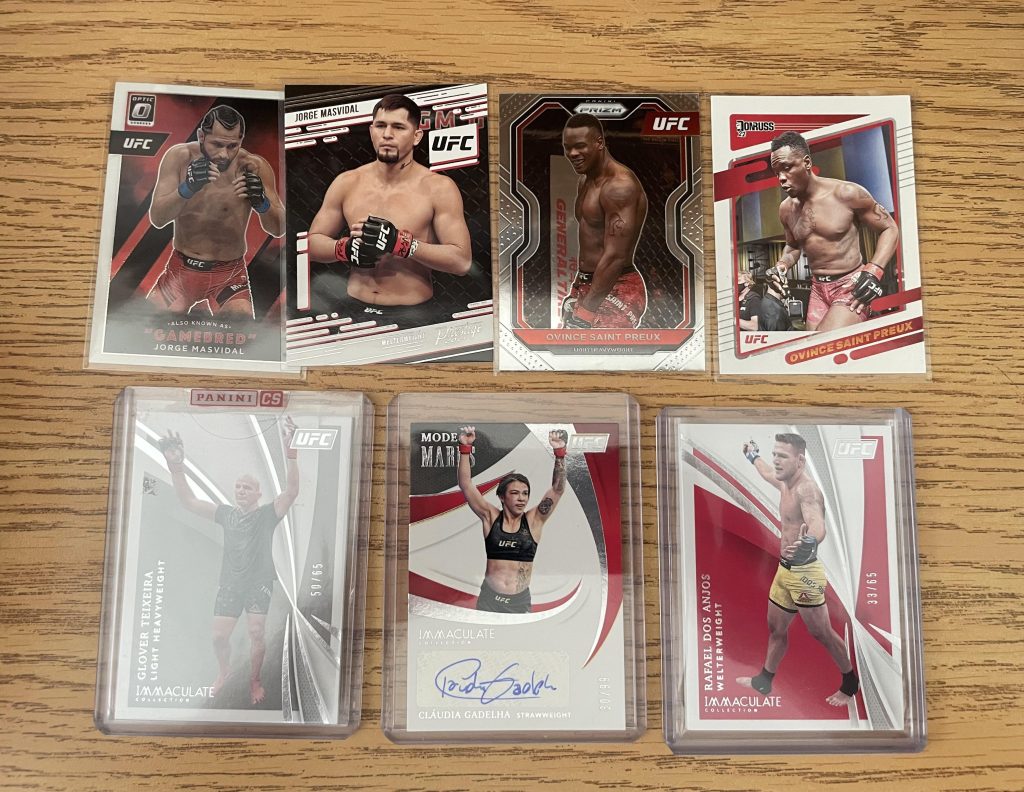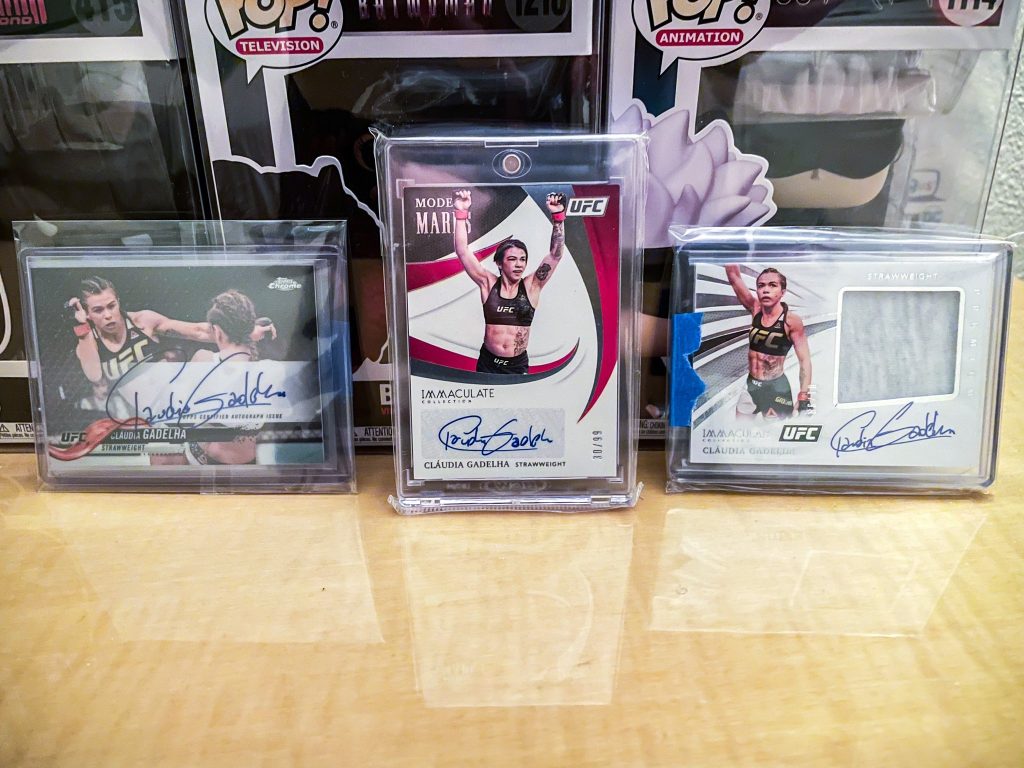Mint cards come from knowing how to store trading cards safely and properly. If you’re a collector of trading cards, you know the condition is everything. Learn the proper way to store sports cards and how they can help prevent damage from moisture, light, and other environmental factors.
In this guide, we’ll explore the best ways to store trading cards to ensure they stay in top condition for years to come. The better the condition, the more potential value they’ll have, especially regarding grading.
The Best Storage Options for Your Trading Card Collection
A card in poor condition will get a PSA of 1 or 2, whereas a card in good condition will get a PSA of 10, which could be the difference between hundreds and thousands of dollars. Protecting cards to preserve their condition applies to sports and trading cards.
For example, a Pokémon Blastoise PSA 2 costs around $50, whereas a PSA 10 is worth $21,000. Which would you prefer to have?
Use our ROI Sports Card Calculator to help you determine which cards are worth sending to PSA for grading based on its cost. Save yourself a ton of time and money sending in cards which won’t produce a high return on your initial investment.
Let’s dive in and start with the basics:
Choose the Right Type of Sleeves or Holders

Understand the difference between cardholders and sleeves. One of the most important aspects of storing your trading cards is choosing the right type of sleeves or holders. Many options include top loaders, penny sleeves, and magnetic holders.
1. Penny sleeves
Penny sleeves are an affordable option but may provide less protection.
These are loose; a card can still bend in a penny sleeve. However, similar to its name, these sleeves are only worth a few pennies making them a popular choice.
It’s best to push the card up from the bottom and grab the sides without pressing your fingers on the card’s surface, as that can cause unnecessary damage.
Additionally, penny sleeves can combine with top loaders. It helps prevent warped sports cards.
A beginner question collector have is, ‘Do you put a penny sleeve on the card first when putting on a top loader, or do you leave it separate?
Always use a penny sleeve before putting your card into a top loader; this prevents scratching the card’s surface when putting it into a top loader.
2. Top loaders
These are popular for their durability and ability to protect cards from bending or creasing. They have hard plastic, which prevents dust from getting inside and on the card while also providing vital protection from fingerprints. The oils on your fingers can cause damage to a card, and this prevents putting them all over them.
There are multiple-size top loaders. You’ll want to know more about Normal vs. Oversized Top Loaders.
Regular top loaders are approximately 3 inches (7.6 cm) in width and 4 inches (10.2 cm) in height. A standard card size will fit perfectly in this protective case; however, some thicker cards will not.
Oversized top loaders are available for larger cards, such as jumbo-sized or memorabilia cards. Typically, a more significant top loader will cost more as it takes more material to create. Remember what type of cards you prefer to collect, and which proper protection makes the most sense.
For example, some thicker cards are better to display in a One-Touch protective case. Others call these cases ‘Single Touch’ or ‘Magnetic Holders.
3. Magnetic holders
A great way to display cards, but there may be better choices for long-term storage. Magnetic holders have two magnets at the top of the case, which allows the case to close safely and securely. They are well-known for putting higher-value cards in these as they are easier to showcase your big hits, and the thickness provides extra protection a top loader can’t. S
Similar to the question about penny sleeves, these magnetic holders can also include a penny sleeve as it helps protect the card’s surface from scratches. However, it does not require a penny sleeve.

Consider the value and rarity of your cards when choosing the right type of sleeve or holder. Here’s the approach we use and encourage other collectors to use.
- Penny Sleeves for any cards around $2 – $9 worth
- Top loaders (with Penny Sleeves) for any hits over $10 worth
- Magnetic cases (with Penny Sleeves) for any cards over $15 worth
Of course, if the card is a personal favorite or a highly sought-after card (even if it’s a standard or base card), you can put them into a Magnetic case or whichever you prefer. However, collectors also expect to see others put higher-value cards in Magnetic cases.
We recommend avoiding putting cards in binders as these tend to damage cards after years in the plastic. The cards become stuck between the binder plastic protectors, causing the surface of your cards to feel the effects.
Store Your Cards in a Safe and Dry Place
Where should you store your trading cards? When storing your trading card collection, keeping them in a safe and dry place is essential. Moisture and humidity can damage your cards, causing them to warp or even grow mold. Avoid storing your cards in areas with high humidity, such as basements or attics. Instead, opt for a cool, dry room with good ventilation.
Here’s a list of safe locations to keep trading cards without causing damage to them. Typically, they are in some form of a box, like a shoe Box, a Protective box like a Zion, or a complex carrying case)
Safe Places include due to comfortable climate control:
- Closet in Box
- Dresser or Draw Inside Cabinet
- Under your bed in Box
- A spare room or extra room in the house
Not Safe places include due to the heat during the day:
- Garage
- Attic
- Basement
- Kitchen – You’d be surprised how often people leave cards in their kitchen near the hot stove.
- Storage Units
You can also invest in a dehumidifier to help regulate the humidity levels in the room. Keep your cards away from direct sunlight, as UV rays can fade the colors and damage the cards over time.
You’ll find some top loaders left in storage units or proper places that will turn yellow after multiple years. Avoid this altogether when you buy high-quality top loaders; it may cost a few more cents per card, but in the long run, it’s worth it.
Use Acid-Free Materials to Prevent Damage
One of the best ways to protect your trading card collection is to use acid-free materials for storage. Acidic materials, such as regular cardboard or paper, can cause damage to your cards over time. Acid-free materials, on the other hand, are designed to be safe for long-term storage.
Look for acid-free sleeves, top loaders, and storage boxes to keep your cards pristine. You can also use archival-quality binders and pages to organize your collection, ensuring that each card avoids damage.
Relevant Questions About How to Store Trading Cards
Here is a selection of questions from your list that are most relevant to storing trading cards:
1. How do you store expensive cards?
When storing expensive cards, use protective sleeves or card holders made of acid-free polypropylene or Mylar. You can also place them in a rigid plastic top loader or a magnetic card case for added protection.
2. How do you store cards safely?
To store cards safely, keep them in a cool, dry place, away from direct sunlight and extreme temperature fluctuations. Store them in protective sleeves, card holders, or binders to prevent damage from handling or environmental factors.
3. How do you store sports cards in a binder?
Use nine-pocket pages specifically designed for trading cards to store sports cards in a binder. Place each card in a protective sleeve and then insert them into the pockets of the binder. Make sure not to overcrowd the pages to avoid bending or warping.
4. How do you store unopened sports cards?
Unopened sports cards, such as sealed packs or boxes, should be stored in a cool, dry place. Use plastic storage containers or sleeves to protect them from dust and potential moisture damage.
5. Is storing cards in top loaders or card savers better?
Both top loaders and card savers offer good protection for individual cards. Top loaders are rigid plastic holders, while card savers are semi-rigid plastic sleeves.
The choice between the two depends on personal preference and storage requirements. Top loaders may provide more robust protection but take up more space, while card savers are more compact and suitable for larger quantities of cards.
As a collector, you’ll find you will have more top loaders than one-touch magnetic holders simply due to the cost savings. Additionally, penny sleeves are the most cost-effective protection for your trading cards.
6. Is it OK to store cards in a binder?
Storing cards in a binder is a popular option for organization and display. However, it’s essential to use appropriate binder pages and protective sleeves to prevent damage. Ensure the binder is stored in a climate-controlled environment to avoid moisture or temperature-related issues.
7. How do you store Panini cards?
Panini cards can be stored using the same methods as other trading cards. Use protective sleeves, card holders, or binder pages designed for trading cards to protect them from damage.
8. How do you keep trading cards in mint condition?
To keep trading cards in mint condition:
- Handle them with clean hands and minimize touching the surface of the cards.
- Use protective sleeves, top loaders, or cardholders to prevent bending, scratching, or exposure to moisture.
- Store them in a cool, dry place away from direct sunlight.
Remember, maintaining the condition of trading cards is crucial for their long-term value and enjoyment. Choosing suitable storage options and following proper handling practices ensures that your trading card collection remains in top condition for years.
Why Storing Sports Cards Is Essential to Preserving Their Value
The bottom line is that adequately storing trading cards is essential for preserving their value and longevity. You can protect your cards from bending, creasing, and other physical damage by choosing the right type of sleeves or holders, such as top loaders or premium sleeves.
Using our methods to sort and protect your cards based on penny sleeves, top loaders, and one-touch magnetic cases, you’ll keep your investments safe for the long term.
Additionally, storing your cards in a safe and dry place, away from moisture and direct sunlight, will prevent warping, fading, and mold growth. Using acid-free materials for storage and organization safeguards your collection against long-term damage.
By following these storage guidelines and addressing relevant questions regarding card storage, you can maintain the condition of your trading cards and maximize their long-term value. Remember, investing in proper storage solutions is an investment in the longevity and enjoyment of your trading card collection.
If you enjoyed reading this article, you may also like:
Sports card hobby enthusiast (originally from New York) who can’t resist ripping cards and eating donuts on the weekends. Passionate about all collecting, have been collecting football cards and other memorabilia for half a decade. Enjoys going to card shows, visiting card shops and getting to know other collectors. Owner of NOWCollectibles a collectible e-commerce business – online card shop for buying affordable cards helping connect sports fans with their favorite teams and players. Follow my personal IG to see PC: @NowCollects See my latest articles here: NowCollectibles Articles (thinksportscards.com)
